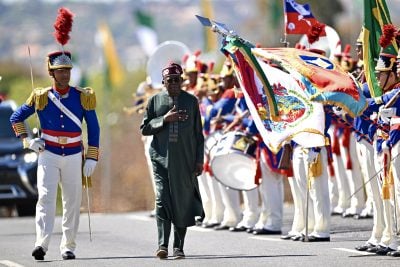Matatus are a cheap and colourful way to get around Kenya’s capital, while driving one’s own car is a mark of one’s status. But amidst Nairobi’s congestion, can commuters be convinced to take a different route?
The chaos of a Nairobi traffic jam has to be seen to be believed. Many Nairobians set their alarms for 5am or even earlier to make sure they can be at their desks by 8am, but logic-defying jams can be found at almost any time of day. Covering the 10 miles from downtown to Kenyatta airport can take anything between 20 minutes and two hours.
Nairobi is a city in a hurry. The Kenyan economy is growing at over 5%, much of it driven by its capital city, whose population has swelled to around 3.5m. This population growth and wealth has inevitably brought with it more traffic and more congestion.
The city’s public transport is dominated by matatus – essentially, beaten-up minivans that transport up to 14 passengers per vehicle. Since the 1990s, when the Kenyan government allowed the city’s formal bus network to collapse and be replaced by matatus, most of Nairobi’s population has relied on this network of privately run minivans.
Typically adorned with the colours of Manchester United, Chelsea or another European football club, and pumping out reggae, rap or gospel music, matatus are, at first glance, a far more cheerful way to commute than the silent anonymity of the London or Paris underground.
Matatu drivers are invariably innovative, skilled, and dangerous. Mounting the pavement, overtaking in static traffic – sometimes by driving towards oncoming traffic – are just some of the tricks of the trade. Matatus are also relatively cheap, a single trip costing between 20 and 60 Kenyan shillings (20-60 US cents).
However, matatus are a far from perfect system. Along with motorbike taxis and the 10,000 new cars registered in Nairobi each month, these minivans often get caught in the gridlock of the bustling city.
The system is also inefficient in other ways. Outside peak times, for example, it can be hard to find a matatu. And rather than adhering to a daily timetable, the vehicles typically do not leave their stations until they are full.
In fact, the state of the transport system is a source of consternation amongst many of Nairobi’s inhabitants, who see it as ineffective, anarchic and outdated.
According to Dorian Kivumbi, head of transport and infrastructure for the European Union in Kenya, this situation ought to be a source of urgent concern for the government. The city’s transport network is “heading for total meltdown in 10 years”, he says. “Most of the transport network dates back to colonial times. It’s old and not up to scratch.”
Rapid change
With Nairobi rapidly cementing its status as a regional hub, and Kenya as East Africa’s leading economy, the government has recognised the pressing need to address its deep infrastructural shortcomings. In order to do this, it has developed a series of grand plans – known collectively as the Mass Rapid Transport System – to overhaul the transit system.
The project involves the upgrading of several highways as well as the building of 167km of new roads and rail transport to connect Nairobi to the satellite towns of Ruai, Kasarani, Westlands and Kayole. But the centrepiece of the plan is a $1bn bus network.
The blueprint of this plan, which involves five separate transit lines, is currently still at the stage of working out what new infrastructure will be needed. But the overall cost is estimated to be large; Kivumbi estimates that each kilometre of dedicated bus lane will cost $3-5m.
In conjunction with the Kenyan government, the project will be funded by partners including European Union (EU), World Bank and African Development Bank. As part of the Cotonou agreement in 2000, a treaty with the EU, European governments are encouraged to focus their development policies on building infrastructure and developing the private sector.
“There are huge opportunities [in transport investment] but the government does not have the money to fund the infrastructure gap,” says Gitahi Gachahi, chief executive of accountants Ernst & Young in East Africa.
Not for free
When it comes to addressing Nairobi’s traffic chaos, however, many policymakers and locals agree that the solution is not to simply build more infrastructure. Nairobi has built more than 100km of new roads around the city over the past decade, but this has done little to improve the flow of traffic.
“We have a battle to fight the perception that building more roads will solve the problem,” says Kivumbi. He argues instead that more attention is needed on issues such as street lighting and cycle lanes, which would make life easier for the estimated 40% of Nairobians that travel by foot or bike.
Changing perceptions about car travel in general will be another difficult challenge of a different sort. Despite a real estate boom, mortgage rates are prohibitively high for many middle-class Kenyans, which means a second-hand Toyota – or, if your wallet can stretch that far, a Land Rover – is often the next best status symbol.
Persuading Nairobians, many of whom are just starting to enjoy the fruits of the country’s new-found wealth, to give up their cars for a bus or train could prove tricky.
Furthermore, building effective transit systems will be just the beginning of the journey. The county governors of Kajiado, Kiambu, Nairobi and Muranga, whose provinces will be affected by the plan, signed a joint memorandum of understanding last October to set up the Nairobi Metropolitan Transport Authority. This eight-member steering committee began work in March. But it remains to be seen how well they will organise and manage the upcoming transit systems.
One question they will face is of how high or low to pitch the fares. Is the first priority to lure middle-class Kenyans from their cars to the buses, or is the first goal to offer cheap-enough fares in order to be able to attract those who cannot afford to travel by matatu?
Kivumbi suggests a bit of both could be possible through different means. He argues that the bus network could pick up middle-class Nairobians, while a commuter rail system could cater to Kenyans unable to afford to travel on either buses or matatus.
Either way, some form of government subsidy for the network is inevitable, says Kivumbi, who contends that the government will have to realise that public transport systems do not turn a profit. “This is not for free, guys. You’re going to have to pay for it,” he says.
Goodbye matatu?
Construction of the bus lanes will take between three and four years, and while Kenya’s Jubilee government would like to have a pilot line running by 2017, in time for the next round of parliamentary elections, it is more likely that the buses will only hit the road by around 2020. When they finally arrive, it is hoped that the new buses will transform how people get around in Nairobi. However, not everything will change. The well-travelled matatus, for example, will continue to play an important role.
Perhaps partly because the government is anxious to avoid making an enemy of the matatu operators – a powerful lobby group who could easily bring Nairobi to a standstill if they wanted to – policymakers have envisaged that matatus will provide a feeder service, bringing passengers to and from the five new routes. Rather than attempting to squeeze out the old service, the government says it wants to promote the bigger and better-run matatu operators.
For those who travel around Nairobi every day, the prospect of the city adapting to a more European-style public transport system is tough to comprehend. Furthermore, imagining a Nairobi no longer dominated by traffic jams and the anarchy of the current system still seems a distant ideal.
However, according to Kivumbi, the political will to see this project through is there. “They know that this is the only way for Nairobi,” he says.
However, as most Nairobians will know, it will take more than just political will to coax Kenyans out of their cars and end commuters’ reliance on matatus.
Benjamin Fox
Want to continue reading? Subscribe today.
You've read all your free articles for this month! Subscribe now to enjoy full access to our content.
Digital Monthly
£8.00 / month
Receive full unlimited access to our articles, opinions, podcasts and more.
Digital Yearly
£70.00 / year
Our best value offer - save £26 and gain access to all of our digital content for an entire year!
 Sign in with Google
Sign in with Google 


